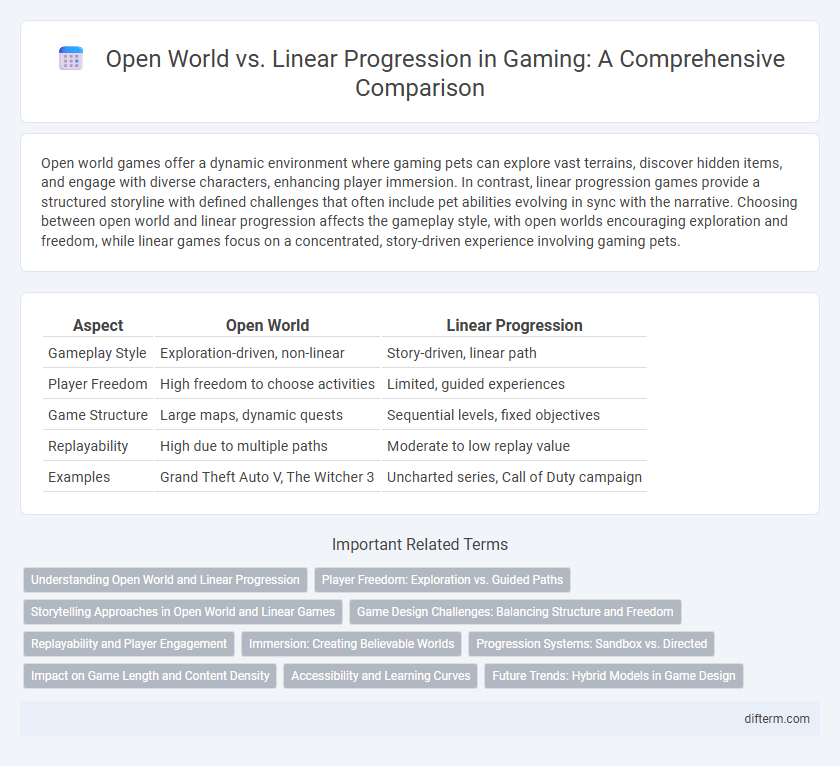Open world games offer a dynamic environment where gaming pets can explore vast terrains, discover hidden items, and engage with diverse characters, enhancing player immersion. In contrast, linear progression games provide a structured storyline with defined challenges that often include pet abilities evolving in sync with the narrative. Choosing between open world and linear progression affects the gameplay style, with open worlds encouraging exploration and freedom, while linear games focus on a concentrated, story-driven experience involving gaming pets.
Table of Comparison
| Aspect | Open World | Linear Progression |
|---|---|---|
| Gameplay Style | Exploration-driven, non-linear | Story-driven, linear path |
| Player Freedom | High freedom to choose activities | Limited, guided experiences |
| Game Structure | Large maps, dynamic quests | Sequential levels, fixed objectives |
| Replayability | High due to multiple paths | Moderate to low replay value |
| Examples | Grand Theft Auto V, The Witcher 3 | Uncharted series, Call of Duty campaign |
Understanding Open World and Linear Progression
Open world games provide vast, explorable environments where players choose their own paths, offering freedom and emergent gameplay experiences. Linear progression titles guide players through a set sequence of levels or story events, emphasizing narrative control and paced challenges. Understanding these design philosophies helps gamers select experiences tailored to their preferences for exploration versus structured storytelling.
Player Freedom: Exploration vs. Guided Paths
Open world games maximize player freedom by offering expansive environments that encourage exploration and discovery without predetermined routes. In contrast, linear progression games guide players through carefully designed paths that focus on narrative flow and controlled pacing. This distinction impacts player agency, with open worlds promoting emergent gameplay and linear games delivering structured storytelling experiences.
Storytelling Approaches in Open World and Linear Games
Open world games employ nonlinear storytelling by allowing players to explore narratives at their own pace, creating emergent stories influenced by player choices and environmental interactions. Linear progression titles deliver tightly controlled narratives with structured pacing, ensuring a focused and immersive storytelling experience that drives character development and plot clarity. Both approaches shape player engagement differently, with open world games emphasizing freedom and discovery, while linear games prioritize cohesive, cinematic storytelling.
Game Design Challenges: Balancing Structure and Freedom
Open world game design challenges revolve around providing expansive environments that encourage exploration while maintaining engaging objectives to prevent player aimlessness. Linear progression demands meticulous pacing and narrative control to ensure a cohesive and compelling story, but risks limiting player agency and replayability. Striking a balance requires dynamic systems that adapt to player choices, blending structured missions with emergent gameplay to optimize immersion and satisfaction.
Replayability and Player Engagement
Open world games offer high replayability due to expansive environments and multiple quest paths, encouraging exploration and varied player experiences. Linear progression games deliver tightly crafted narratives and focused challenges that enhance player engagement through clear objectives and pacing. Balancing open world freedom with structured progression can optimize both sustained interest and story immersion in gaming.
Immersion: Creating Believable Worlds
Open world games enhance immersion by offering expansive, interactive environments where players shape their journey, fostering a sense of freedom and realism. In contrast, linear progression provides controlled narratives that streamline story delivery but may limit exploration and dynamic player experiences. Immersion thrives in open worlds through detailed ecosystems, diverse NPC behaviors, and emergent gameplay that cultivate believable, living worlds.
Progression Systems: Sandbox vs. Directed
Sandbox progression systems in open-world games empower players to explore and develop skills at their own pace, fostering creativity and personalized gameplay experiences. Directed progression in linear games guides players through carefully designed challenges and storylines, ensuring a structured and coherent narrative flow. Balancing player autonomy with narrative control shapes the core dynamics between sandbox and directed progression models in game design.
Impact on Game Length and Content Density
Open world games typically offer extended playtime through expansive maps filled with numerous side quests and exploration opportunities, resulting in higher content density and player-driven pacing. Linear progression games focus on a tightly curated experience with concise storytelling and structured levels, providing shorter but often more intense gameplay sessions. This difference impacts player engagement, with open worlds encouraging prolonged immersion and linear games delivering a focused narrative impact.
Accessibility and Learning Curves
Open world games offer high accessibility by allowing players to explore environments at their own pace, reducing entry barriers for newcomers through non-linear learning curves. Linear progression games provide structured pathways with clear objectives, making it easier for beginners to understand mechanics and advance steadily. Balancing freedom and guidance impacts player engagement, as open worlds encourage experimentation while linear designs support focused skill development.
Future Trends: Hybrid Models in Game Design
Hybrid models in game design combine open world exploration with linear progression to create balanced player experiences that cater to different playstyles. These models leverage adaptive storytelling and dynamic environments enhanced by AI to offer personalized challenges and content pacing. Emerging technologies like cloud gaming and procedural generation further optimize hybrid designs by enabling expansive, seamlessly integrated worlds with structured narrative arcs.
open world vs linear progression Infographic

 difterm.com
difterm.com